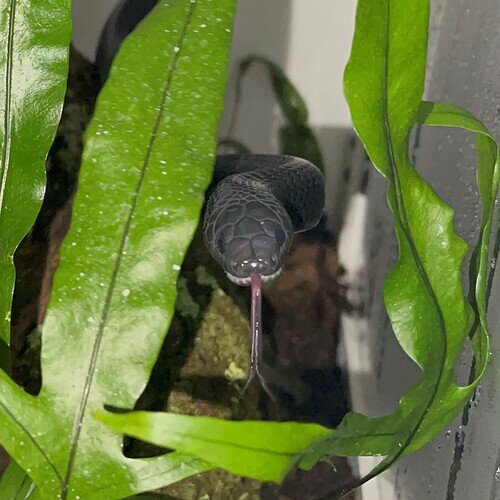Someone was checking me out last night
He/she smelled what your saying 

So do all your guys come out for “check out my cute little face” photo night? Or day or whatever? Lol! 





Nah. I just tend to be quick with the camera when I can and have a surplus of pic that I decided to start posting up
The alterna are always begging and are comfortable being out. This girl (black milk) was out because it was feed night and she was sniffing around. The Rhamphs like to bask but 99.99999% of the time they bolt as soon as I reach for the door. The rubbers pop out now and then to bask but spend most of their day hunkered down. The Candoia and bredli bask out in the open so they are easy to photo. The Calabars are only ever out at night or maybe around five minutes after the lights come on. The mole snake I only see if I dig her up. The kukri are about halfway between the rubbers and the Calabars, mostly hunkered down but sometimes out in the day.
Ok so here is probably a dumb question but the kukris, calabars, and the rubber snakes are all in separate enclosures right?
Also is the snake called the “red beaked” snake in any remote way related to your beaked snakes? Somewhere down the line?
Also is it difficult to obtain finch eggs etc eggs for egg eating snakes?
The beaked snakes and the egg eating snakes have always appealed to me…….
Just curious 
No dumb questions
Environmental conditions are very different for these three species so in that regard, yes, they have their own enclosures. However, my adult 1.2 Calabars I cohab in a 2.4m cage (and as the younger ones get to size they will join them) and the rubber boas I cohab as well. The kukri are quite territorial - and also have reports of cannibalism - so I house each of them individually.
.
.
.
All three of the beaked species in the hobby are genus Rhamphiophis, so they are related in that regard. @ntam has a great graphic that she put together comparing/contrasting the three species. If I can remember, I will try to post it in here unless she beats me to it
There is a fourth “beaked” snake that is not in captivity to the best of my knowledge, Dipsina multimaculata, that is in the Psammophis group but more distantly related
.
.
.
Depends… If you know anyone that breeds finches then you should be fine. If you do not then it is a bloody nightmare.
That said, adult Dasypeltis and all kukri are fine with quail eggs. I use an egg cutter to cap the eggs for kukri. Dasy just swallow them whole and spit out the shells (really cool to watch)
.
.
.
As a note, eggs do not seem to be a food item for beaked snakes, at least none of mine have ever expressed an interest.
Dasypeltis are a great genus but 99% of people that keep them are doing it wrong. Firstly, they are an incredibly arboreal species, and I would contend they need a cage at least as high and as wide as they are long. Secondly, they are very much evolved for a boom/bust feeding cycle and are not physiologically equipped to deal with sustained year-round feeding. I have a very disturbingly graphic necropsy video from my animal that shows her liver was 80% fatty tissue. Despite that I was intentionally feeding her on a season cycle, it is painfully obvious that even with that I was overfeeding her. And lastly, these animals have very very delicate bones and are easily subject to damage to their spine that leads to kinks. As such, they should really not be handled in any manner that might cause even the slightest force
Ok thank you so much for this information! I am glad I asked first. It’s so much better to know beforehand what a particular species of snake needs for quality of life before the purchase is made.
I think I will stick with what I know! And can handle! lol!
Thank you again!!! 




